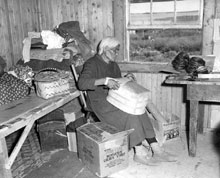of Northern Saskatchewan
r
e
h
i
s
t
o
r
y

Archaeologists suggest that the ancestors of the Dene first came to this land between 8,000 and 12,000 years ago. It is speculated that they, like many Aboriginal peoples before them, crossed the land bridge that had formed between Alaska and Russia, across the Bering Strait.
Stories of a time "when the world was new" (Blondin, 1990) support migration and a long journey full of difficulty. Alexander Mackenzie was told, in 1789, that "their ancestors lived till their feet were worn out with walking." (Mackenzie, p. cxviii)
They tell of a long journey of cold and hardship to escape from a land of wicked people.
r
e
h
i
s
t
o
r
y
Another story details a fight between two giants. With the help of his grandson, one giant killed the other. When the dead giant fell, his head was in North America and his body formed a bridge to another country, "and then the deer for the first time ran from the new land into this country." (Lowie, p. 189)
However, languages related to the Dene tongue are spoken in regions far to the south and to the west in what is today the United States. Does this mean that groups kept travelling south? How did these southern groups lose their relationship with the caribou? Is it possible that the Dene migrated northward? Many questions need to be answered before a definitive answer can be found.
It is clear that the Dene of northern Saskatchewan took many years to reach this area. We can only glimpse clues to the route that they took to get here.
![]()
i
s
t
o
r
y

First contact between the Dene and the Europeans did not occur in this area until the early 1700's, although the existence of the former was well-known through reports by the Cree, the middlemen in the fur trade. The Dene were referred to as Northern Indians at this time. In 1714 the Dene were brought into the fur trade through the efforts of Thanadelthur, a Dene woman who had been captured by the Cree. (Her story is told below, under the section entitled Dene Stories).
In 1717 the Hudson Bay Company built Fort Prince of Wales at the mouth of the Churchill River. This was the fulfillment of a promise to Thanadelthur, to provide easier access to trade for her people. By this time Dene territory stretched from the Thelon River to Lake Athabasca, and from the eastern end of Great Slave Lake to the coast of Hudson Bay.
i
s
t
o
r
y
Although conflicts with the Cree and Inuit were not uncommon, small, nomadic populations kept these encounters to a minimum for a time. By the late 1700's the Dene began to move further south. By now they were referred to as "Caribou-Eaters" for their dependence on this animal for all their needs, or Chipowyan (Chipewyan) from the Cree word cipewayanawuk meaning "pointed skins". This was in reference to the distinctive style of clothing worn by the people.
Historians suggest several reasons for this southward expansion. Smallpox epidemics had decimated the Cree populations to the south; the Dene were also weakened by this disease and perhaps moved from their traditional lands to escape the devastation. Fort Prince of Wales had been destroyed by the French, and the fur trade was expanding around Lake Athabasca to the west and Nueltin Lake to the east.
By the middle of the 19th century the Dene occupied territory as far south as the Churchill River.
In 1899 members of what are now the Fond du Lac and Black Lake First Nations agreed to the terms of Treaty 8. The treaty was signed by Maurice Pich (also known as Moberley) as Chief, and by Laurent Tsaddie or "Dzieddin" (The Deaf) and Toussaint, both Headmen. Louis Robillard and Father Gabriel Breynat, O.M.I. acted as interpretors. By 1906 the Dene in the rest of the province - the Lac La Hache Band from Wollaston Lake, and the Clear Lake and English River Bands from Dillon, Patuanak, and Turnor Lake - had taken treaty. Included in this Treaty 10 agreement were the members of the Barren Lands Band who occupied the territory around Brochet, Lac Brochet and northward to Nueltin Lake.
It should be noted that the Portage La Loche Band, as they came to be known, were originally from Fort McMurray. A 1920 federal government report indicates that they numbered 66. Despite several initiatives over the next few years, it was not until 1970 that these people, now the Clearwater River Dene Nation, were granted land for a reserve.

o
d
a
y
Today the people called Dene, or Denesuline, of Saskatchewan occupy three geographic areas:
- The westside communities of Patuanak, Dillon and area, La Loche and area, and Turnor Lake
- Wollaston Lake
- Fond du Lac, Black Lake and Stony Rapids
o
d
a
y
For more background on the Dene people of Northern Saskatchewan check these links: